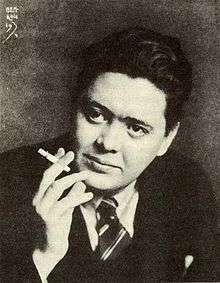Waldemar Hammenhög
| Waldemar Hammenhög | |
|---|---|
 Hammenhög in 1934 | |
| Born |
Per Waldemar Hammenhög 18 April 1902 Stockholm, Sweden |
| Died |
1 November 1972 (aged 70) Stockholm, Sweden |
| Occupation | Novelist |
| Nationality | Swedish |
| Notable works |
Esther och Albert (1930) Pettersson & Bendel (1931) Torken (1951) Omne animal (1952) |
Per Waldemar Hammenhög (April 18, 1902 – November 1, 1972) was a Swedish writer and novelist.[1] The trivial, petty bourgeois urban environment forms the basis of many of his early realistic novels, whereas his later works turned towards religious and moral issues.[2] Writing more than 40 novels, Hammenhög is probably best known for Pettersson & Bendel (1931), a humorous novel adapted twice to screen.[3]
Life and work
Born in Stockholm in 1902 as Waldemar Anderson,[4] he was the son of foreman Per Anderson and his wife Lydia Källgren.[4] After graduating from the Högre realläroverket å Östermalm high school in Stockholm in 1919,[4] Hammenhög worked as an office boy,[4] and later office clerk until 1930.[1] He left his job as a clerk after he was awarded first-prize in a novel competition organized by the Stockholm-based publishing house Natur & Kultur with his debut novel Esther och Albert.[1] He submitted the text under the pseudonym "Hammenhög", which became his official name in 1931.[5]
Among Hammenhög's writing highlights is the humorous novel Petterson & Bendel (1931), adapted to screen in 1933 starring Adolf Jahr as Pettersson; and as P&B (1983) starring Stellan Skarsgård as Petterson and Allan Edwall as Bendel. Esther och Alberts äktenskap (1936) was also a success, adapted to screen as Ung man söker sällskap (1954), starring Ulf Palme and Gaby Stenberg.[6]
In the late 1940s, Hammenhög's writing turned from realistic humor towards moral issues as he was struggling with personal alcoholism.[3] His writing reached a turning point with Torken (1951),[7] a novel about the failure of traditional alcoholic care. The novel is sometimes regarded as Hammenhög's second breakthrough as a novelist.[2] A year later, Hammenhög published Omne animal (1952), a novel which implied that Hammenhög was heading toward Roman Catholicism. Most novels that followed often focused on religious and moral issues.[2]
Later life and death
Hammenhög's early commercial success as a productive novelist[5] led to an extravagant lifestyle, and severe alcoholism.[3] For years, alcoholic problems influenced his writing which was largely devastated by superficiality and haste.[8] Later in life, Hammenhög became a "sober alcoholic".[3] In that capacity, he frequently spoke in public about issues related to his alcoholism.[3][8]
Writing in newspapers, his signature was W H-g.[1][4] Hammenhög died in Stockholm in 1972 at the age of 70.[1] He is buried at the Roman Catholic Cemetery, a part of the Norra begravningsplatsen Cemetery in Solna Municipality north of Stockholm.[9]
Bibliography
- 1930 – Esther och Albert (novel)
- 1931 – Pettersson & Bendel (novel)
- 1934 – Lindbergs (novel)
- 1935 – Svenske Apollo (novel)
- 1936 – Hustru eller lakej (novel)
- 1936 – Esthers och Alberts äktenskap (novel)
- 1937 – Anna Sevardt (novel)
- 1938 – Uppvaktningen och andra noveller
- 1938 – Det är bara ovanan, damen (novel)
- 1939 – Fallet Antonsson (detective novel)
- 1939 – Fallet Sehling (detective novel)
- 1939 – Löpande band (novel)
- 1940 – Kärälskeliga vänner (novel)
- 1941 – Svar med amatörfoto (novel)
- 1942 – Edens lustgård (short stories)
- 1942 – Erik, skogsluffaren (Sports book for youths)
- 1942 – Det var en gång en musiker (novel)
- 1943 – Nils, skolungdomsmästaren (Sports book for youths)
- 1944 – Pettersson & Bendels nya affärer (novel)
- 1944 – Olle, brottaren (Sports book for youths)
- 1945 – Sven, skidlöparen (Sports book for youths)
- 1946 – Hur mycket skall du ha (novel)
- 1947 – Halvbröderna (novel)
- 1949 – Livia (novel)
- 1950 – Sol och vår. Dokumentariska närbilder. (together with Bertel Janson)
- 1950 – Pettersson och Bendel på Sicilien (novel)
- 1951 – Torken (novel)
- 1952 – Omne Animal (novel)
- 1953 – I en fransk småstad
- 1953 – Lycklig resa (novel)
- 1954 – I en svensk sovstad
- 1955 – Älsken varandra (novel)
- Den eviga kärleken:
- 1957 – Inledningen till ett drama
- 1958 – Dramat
- Berättelsen om Petter Larsson:
- 1959 – Regeringsgatan
- 1960 – Helga Lekamens gränd
- 1961 – Ensittarvägen
- 1962 – Det är ingen mark att bygga på, min älskade
- 1962 – Berättelsen om Pisinus
- 1962 – I en sydengelsk by
- 1966 – Moderna Häxprocesser
- 1969 – Gustav Tjäder (novel)
- 1970 – Lallo (novel)
- 1971 – Herr Anderson med ett s (novel)
References
- 1 2 3 4 5 Waldemar Hammenhög, Svenskt biografiskt lexikon, 1969.
- 1 2 3 Waldemar Hammenhög, Store norske leksikon.
- 1 2 3 4 5 Waldemar Hammenhög - Pettersson & Bendel, Aftonbladet 1983.
- 1 2 3 4 5 Waldemar Hammenhög, Vem är det : Svensk biografisk handbok, 1957 ed., p. 378.
- 1 2 Vad skriva de härnäst?, Bonniers litterärar magasin, 1932, Vol 2. p. 67-69.
- ↑ Waldemar Hammenhög, Svensk filmdatabas.
- ↑ "Torken" (literally: "dryer") is a Swedish non-standard word for an institution that takes care of drug detoxification.
- 1 2 Waldemar Hammenhög, Nationalencyklopedin Vol 8, Bra Böcker: Höganäs, 1992.
- ↑ Katolska begravningsplatsen, gravar.se.